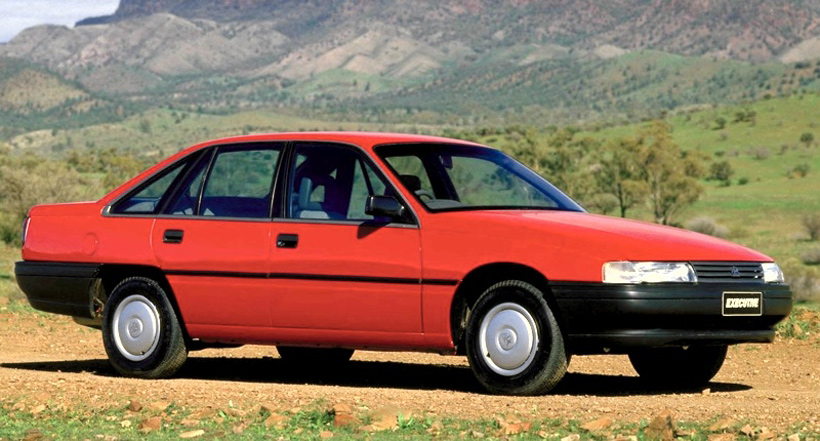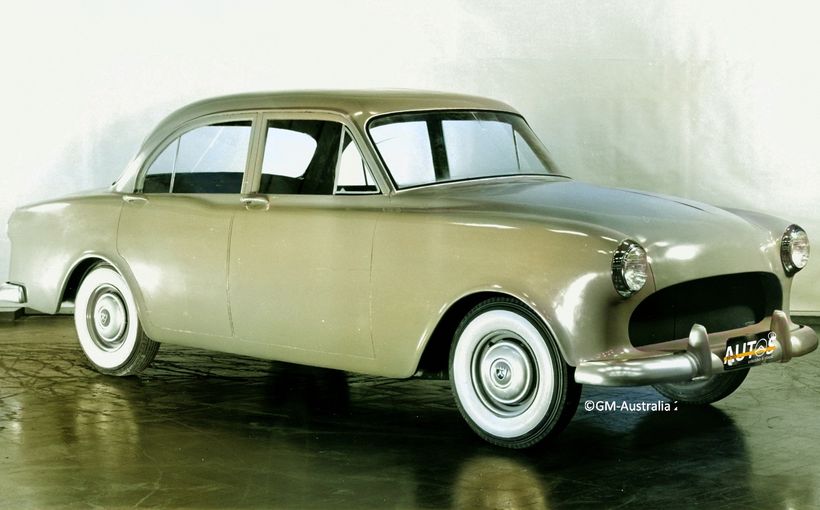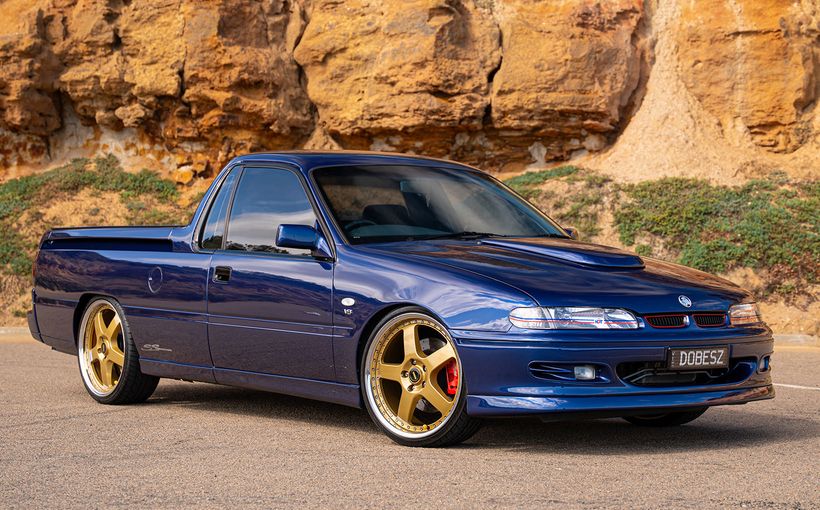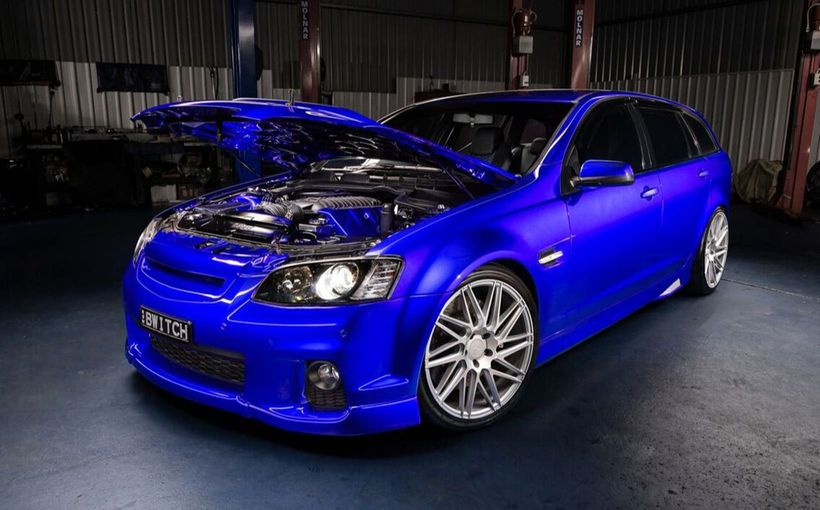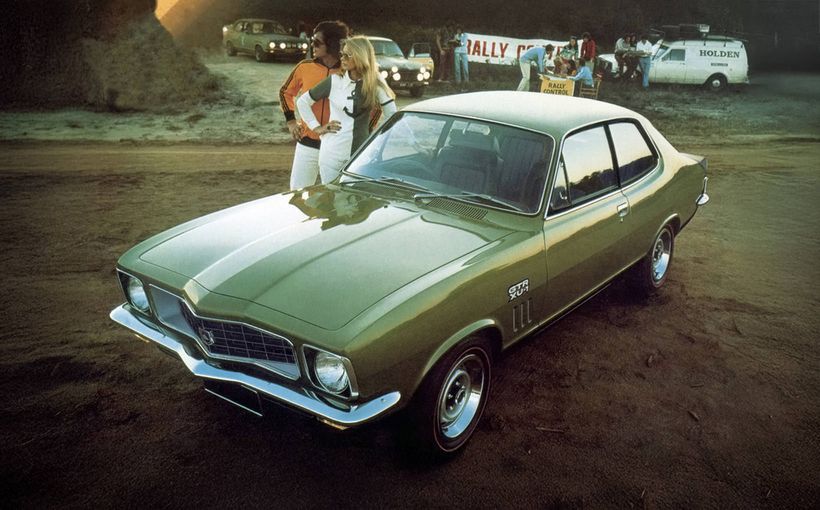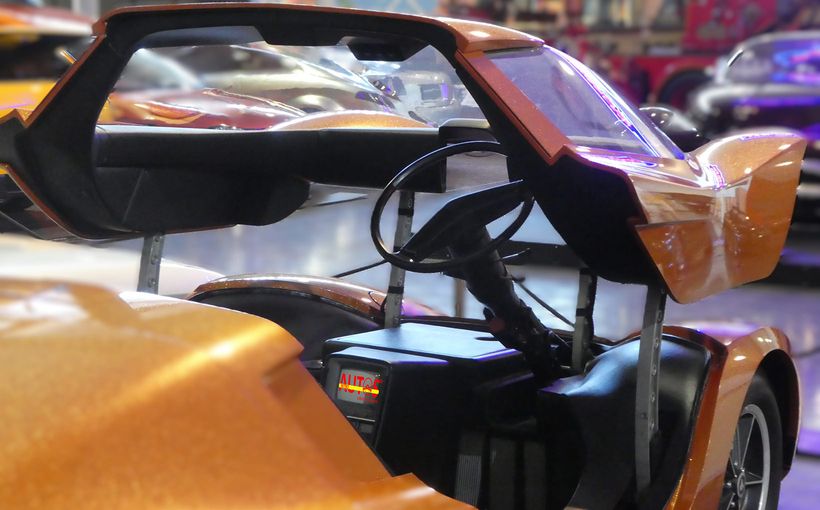1988-91 Holden VN Commodore: Holden Milestone or Unguided Missile?

The August 1988 launch of the VN Commodore marked several Holden firsts. It was the first Australian version of GM’s V-car to meet local large car requirements and thus restored Holden’s viability. As the first mainstream Holden ever to introduce a new body and drivetrain at the same time, it required ongoing development after it reached the showrooms. It generated the first ute and long wheelbase Statesman based on a Commodore. The standard VN’s turn of speed and vulnerability to theft and joy rides prompted reviews of car theft, police chases and anti-hoon laws across Australia.
Even if it proved a popular family car, it was unforgiving in the wrong hands and could activate its own sequence of Darwin’s natural selection in the blink of an eye while its relatively poor crash protection could bring some finality to the process. Its popularity was boosted by a 30-40 per cent price increase of imported rivals after the combination of a newly floated Aussie dollar, tough new Fringe Benefit Tax laws and a combination of tariffs and quotas gave the VN Commodore a free kick at every turn.

It didn’t matter that the VN’s new Buick V6 powerplant was crude, rude and unrefined compared to the VL’s smooth Nissan six. Ford’s new EA Falcon which arrived in March 1988 was worse in almost every department and could no longer rely on a size advantage as a sweetener. The VN’s other smash hit local rival, the Mitsubishi Magna, was on the nose as chronic auto transmission problems and cracked engine blocks started to surface.
Although the Nissan Skyline was the only consistent local competition, its cabin was even tighter than the previous Commodores and it was showing up with diff problems. Against the spacious new VN cabin, all local cars including the popular new local Toyota Camry were on notice.
The VN’s sales potential and improved assembly quality would soon lead to a rebadged Toyota Lexcen version as part of a new joint venture with Toyota. The VN’s arrival coincided with the new “Button car plan” which set minimum volumes for every car built in Australia and encouraged model sharing.
Although it sounded like a good idea at the time, this socialist approach to car manufacture turned local cars into no-name commodities that arguably did more to harm their long term prospects.
The VN also marked the return of a four cylinder Commodore after the 2-litre version of the Camira’s Family II engine was installed for exports. Replacing the 2-litre Nissan six in VL exports, the VN Commodore 2.0 was much livelier than Holden’s old Starfire engine and closer to the latest Opel Omega in Europe. For those buyers who valued fuel economy over outright performance, the VN’s light body made this combination work better than anticipated.
Despite several milestone V8 models from Holden and HSV, the VN Commodore will never be remembered as one of the Holden greats. But some will be remembered much better than others, and not always for the right reasons.

The V6 Models
Despite the hype at release, it is well known that Holden never intended the VN to be powered by Buick’s crude but expedient V6 derivative of its aluminium V8 (the one that ended up under Rover bonnets). Resurrected during the oil crisis, the V6 was dependent on its transverse front drive installation to hide its inherent roughness in later applications. For an old school pushrod iron engine, it always was a surprisingly torquey and economical unit that defied the lack of science behind its creation.
The original plan was for Nissan and Holden to build the next Skyline six locally and stretch it to 3.3-litres. Both companies were under intense pressure to cut the cost of Nissan’s imported drivetrain as it headed northwards of 40 per cent of the dollar content in each car under Keating’s “banana republic” dollar. Holden was concerned whether the Nissan engine could be stretched further to meet future needs. Nissan was worried about the long term prospects of the Skyline after the local Magna’s wide body exposed the Skyline’s biggest shortfall. A crucial year was lost before these plans were shelved.

Holden actually intended to launch the VN with a Nissan six (what a sweet, quiet car that would have been) then follow-up with the V6 as soon as Buick had finished its latest major re-work of the V6. The short story is that Buick fast-tracked the Holden application by working with Holden to allow the V6 to arrive almost in parallel with 1988 US models. It made the Nissan-powered VN unnecessary. It was just as well.
Ford launched the EA with a confusing array of 3.2-litre and two 3.9-litre versions of its new SOHC six, all fuel injected but single-point injection in the two cheaper versions. The 3.8-litre Buick six with premium multi-point injection and the latest 4 speed Turbo-Hydramatic option made Ford’s two single-point engines and the Falcon’s old school local three-speed auto redundant overnight.
Holden’s V6 had just been through a major transformation in the US including a 23 per cent reduction in reciprocating mass, a longer cylinder block that placed the connecting rods in the centre line of the bores and pistons, a Mitsubishi-type balance shaft and a five kg reduction in weight compared to the Nissan engine. It was also shorter, allowing it to sit further back in the engine bay for better balance.
It delivered 125kWat 4800rpm and 292Nm at 3600rpm, most of which was available just above idle. It was enough to make the 1290kg VN Commodore Executive feel like a rag doll under some scenarios.

Despite the hype at the VN’s launch suggesting this was a considered move, Holden barely had time to cobble up a set of exhaust headers, sump, a suitable cross-member with hydraulic mounts, throttle body and related parts, oil filter adaptor and not much else. The long tortuous routes of the first radiator hoses highlight how little time Holden had to switch the V6 from its US transverse front drive application to the rear drive Commodore.
Although the VN Commodore looked like it was derived from the 1987 Opel Senator, there was no relationship under the skin. The new body was stretched over outriggers to cover a wider cabin and boot but at the front it was severely pinched in to match the old Commodore’s narrow front end. The 1451mm front/1478mm rear tracks told the story.

Opel’s latest front suspension design would have to wait another five years for the VR although the VN’s more direct front anti-roll bar mounts were a major advance. Opel’s old live rear axle was replaced by independent rear suspension across the entire Opel/Vauxhall Omega/Carlton/Senator range.
Opel’s latest control link independent rear suspension was mandatory on the more powerful six cylinder models (which were much smaller than Holden’s 3.8-litre) as early as 1987. This design would not be seen on a local Commodore until the VX Series II in August 2001 after a newly arrived Peter Hanenberger overruled the bean counters and insisted on the Holden catch-up. Even then, it was prompted by fears that the reborn Monaro would expose Holden short cuts of the past 14 years.
Instead, Holden’s most powerful standard six ever was still tied to the same four cylinder 1977 Rekord rear suspension, its live axle simply widened to match the new rear. The differences in front and rear track and the very light tail could soon be amplified by the relatively small standard 14 inch wheel and tyre package.

There was another wildcard. During this period, this writer once interviewed dealers on a weekly basis for a series of national used car columns. One dealer in particular based his entire business on turning over near new fleet Falcons and Commodores as they hit 30-40,000km in their first year. He was therefore one of the first to stock a used VN. A tough operator, you could imagine him selling a Lightburn Zeta as a family wagon for a family of five but the arrival of his first used VN exposed a different side.
After hauling me into his office with some ceremony away from his staff, he suggested quite forcefully: “Youse blokes must be on drugs raving about the VN and giving it the Car of the Year.” I took a deep breath and had a fair idea of what was coming. I had driven an early VN Executive V6 or two. They all left me at odds with my colleagues as they struck me as lethal in the wrong hands.
He continued: “I wouldn’t let my wife drive that (pointing to the shiny metallic blue VN on the lot), let alone my teenage kids. There is no progression in that accelerator pedal. You just touch it and all hell breaks loose without warning. It’s as rough as guts.”
“And I now have to sell them to all these hyped-up young blokes that come in here desperate for one.”

At that point, I explained the engine’s origins as a variation of the B-O-P V8 with the wrong V angle for a V6. The latest version was the best it had ever been but the switch to rear drive in the Commodore seemed to spread its indiscretions right throughout the car, not just across the front. It was if the two-piece tail shaft and the live rear axle negated any US gains and the less than rigid body made it worse. As it later turned out, this was not a durability problem. The VN seemed to loosen-up, the drivetrain would shake and vibrate then last forever without any further deterioration like a well-worn pair of Aussie thongs.
Yet this wasn’t the real problem. As evidenced by later models, the geometry of the VN’s original throttle linkages and throttle body operation were wrong. Again, not a bad enough problem on its own but in conjunction with the strong and instant torque, a responsive auto, basic rear suspension, light tail and poor grip, my dealer contact had every reason to be concerned. At least 50 per cent of his core business would soon depend on the VN. Young drivers would soon be his biggest customer base for reasons that will become apparent shortly.

By any objective measure, it was not suitable for a novice driver. It also placed extra shock loads on the entire drivetrain front to rear including all engine and gearbox mounts plus the clever voided suspension bushes vital for the live axle rear to work. This caused problems further down the track as it was too easy to replace vital suspension and steering parts with parts which made the handling twitchier.
Holden worked around the clock to address the issues. Yet plenty reached the road before they were fixed. The VN not only succeeded in rocketing the Commodore up the sales charts but averted the closure of Holden’s local operations.
During 1989, Holden added cast exhaust manifolds which subdued some harshness while the auto transmission and the engine’s throttle response were made more progressive, less like an on-off switch. This upgrade was formalized in a March 1990 upgrade which added an illuminated ignition lock and remote boot release.
As a measure of how far the new car market was skewed towards the locals and how strapped Holden was in refining the VN, the VN continued unchanged in most visible areas for more than three years. The VN V6 milestone was the November 1990 introduction of the VP engine picked by its new top radiator hose entry at the front of the engine and new extruded aluminium fuel rails instead of the pressed steel items. It was another major step forward in refinement.

The VN also represented a quantum leap forward in assembly accuracy and finer tolerances courtesy of new centralized assembly practices at Elizabeth in South Australia. The VN was the product of unprecedented liaison between the design and development teams and those who built them on the line. With the VN’s almost flush aero body, it didn’t happen a moment too soon. Innovations such as a one-piece firewall module glued into place with dash already attached as a single unit were radical for 1988 and couldn’t have happened without this liaison.
However, the Australian family car buyer was now demanding hard information on relative crash performance. Before ANCAP testing, the main source was real accident data based on national hospital admissions, a process that quickly shone the spotlight on the VN.
A hollow new body shell supported by outriggers on a smaller floorpan could never be best practice for crash integrity. The VN was one of several similar stretched models that these new studies exposed. As VN development was still a work in progress, Holden was forced into another rear guard action on crash safety.
As the VN shot to the top of the car theft hit parade, reaching epidemic levels in Western Australia, calls for factory-fitted immobilisers also went into overdrive. There would be little rest for Holden development engineers as these changes had to apply to whatever model was current as soon as they were ready, without a facelift.

The V8 Models
Just as the V6 aggravated VN weaknesses, Holden’s latest V8 soothed them. In a weird reversal of the situation where a more powerful engine would normally expose more rough edges, the March 1989 introduction of the VN’s new fuel-injected V8 delivered several of the most significant Holdens ever.
Special V8 models were tailored to meet specific police requirements. The VN soon owned the national police fleets once monopolized by Ford after local Cleveland V8 police car supply was abandoned on the XF’s arrival late in 1984.
The VN hit the market as the last of Ford’s XE V8 police cars were taken out of service. Pent-up demand for a V8 sedan with enough rear seat width for a burly officer to sit either side of a suspect caused VN police car orders to soar. And with a guaranteed used market, the constant turnover of near new examples was profitable for all parties under the pre-GST system of tax-free new car purchases for government agencies.

The V8’s secret was exceptional smoothness and the fluid-like delivery of its big boost in horsepower and torque. Although the V8 was much quicker than the V6, it was far less brutal. It didn’t need to be. Its 165kW@4400rpm and 385Nm@3600rpm didn’t encounter much resistance with only 1377kg to haul. It was quick then, and still is.
Following the second round of VL Group A racing developments, it was Holden’s first chance to rid the production V8 of its flaws since it first arrived in 1969.
The sequenced heads with centre plug location, reinforced block with extra ribbing below the head bolts, revised cooling passages and injector mounting bosses from the special Group A race engine of 1988 were all there. The twin-throttle body inlet manifold, four bolt mains and roller rockers of the Group A were not needed. The A9L conrods, pistons, crankshaft and heavy duty Tri-metal F770 bearings stayed and there was a proper multi-point fuel injection system with twin plenum chambers for the first time.
Holden sensibly upgraded the V8 suspension and wheel and tyre package to 6.00JJX15/P205/65 HR15 for a better balance between ride and handling. Yet it left plenty of room for HSV to take it several steps further.

Apart from being a useful and unrivalled option across the Commodore range, theV8 also delivered the real prize, the sublime new SS models. Released in Phoenix Red or Atlas Grey only, the VN SS was everything that the base VN models couldn’t be. The mass-produced detailing that hit a new low with the VN Executive was replaced by an exclusivity that belied the mainstream SS build. This was reinforced by an early 1990 upgrade that added sportier Calais front seats and ignition switch lighting.
A special run of 80 SS-based white VN Commodore 8 Plus examples enhanced by HSV appeared in March 1990 with Momo steering wheel, Berlina electrics and upgrades to the air intake and exhaust. Left over white examples were cleared as stock but fully-equipped SS models at the end of the VN model life.

If the VN Commodore had arrived with this V8 in 1988, few could argue that it didn’t deserve the 1988 Wheels Car of the Year award. Just as the Leyland P76 win needed to be qualified as V8 only, so did the VN’s award except the V8 was not released until 1989. If you look at why the Wheels award was withheld from the XD Falcon they applied equally to the VN and then some.
Not only were there more compromises, the VN Commodore was far less Australian than Holden wanted buyers to know. This was 1988, not 1979, and if the VN represented the pinnacle of Australian industry (which it arguably did against such poor local opposition), oblivion was a very real option as soon as the current market distortion was reversed. Some very deft footwork allowed Holden to escape this for a few decades yet.

The VN Group A Post Script
It is beyond this discussion to list every VN Group A upgrade on its November 1990 arrival. Holden acted on the call of race teams for beefier internals which in the end, made the engine more truck-like. History shows most of it wasn’t needed.
More relevant was the fact that the VN Group A would prove to be Australia’s last genuine homologation race special. In the tradition of the Bathurst XU-1 Toranas and the GT-HO Phase III, it was not a better road car as a result. The ZF 6-speed manual transmission was hard work, the massive brakes, tighter Bilstein suspension and huge 17 inch wheels and tyres were a bridge too far for the mattress-like VN platform.
The VN Group A dealt with varied Australian road surfaces in much the same way as a Morgan Plus 8 (once owned by this writer) which relied on its flexible chassis to provide further bump compliance. Far from a 1990s Grand Tourer, the VN Group A constantly generated the impression there was a massive powertrain ready to break loose from its moorings at any time, an impression it also shared with the old school Morgan Plus 8.
Its grip in the wet or on rippled surfaces was tenuous at best and dependent on fresh rubber. In that respect, it revived the raw appeal of an early muscle car except only 300 out of the required 500 found a home. Almost $69,000 was big bickies in 1990-91 when Australians were staring down the inevitable recession.
What is more relevant here is what it wasn’t and why. It was NOT an HSV. It was a Holden conceived, developed and funded by Holden. Holden’s most senior designer Phil Zmood was sent over to work alongside TWR to finesse its aero additions, not TWR’s own consultant Peter Stevens (think Lotus and McLaren) responsible for HSV’s VN models during this period.
John Lindell, whose Holden Motorsport Group oversaw its creation, answered directly to Holden’s sales and marketing heavies, Ross McKenzie and Rob McEniry. The VN Group A was not born out of emotion or sentiment. It was the product of the most calculating and effective long term marketing strategy in the history of the local industry.

Given its effectiveness in distorting the market entirely on emotional criteria, it begs the question whether this strategy took the entire industry down a blind alley and helped sign its death warrant.
Earlier Bathurst homologation models ultimately existed to entice the flood of baby boomer buyers into new car showrooms while making the traditional buyer base feel warm inside at the thought of their car being on the race track. The VN Goup A’s brief was far more pointed.
Fleet demand for the big Aussie cars was now so critical that up to 90 per cent of new Commodore purchases were subject to a business decision, made on behalf of the actual driver. These decisions were driven by the bottom line, not the emotion driving the old “Race on Sunday, Sell on Monday” mantra. The Holden heavies turned this around so that “Race on Sunday, Better Resale on Monday” became the new catch cry. It caught the entire industry napping, especially Ford.
A big family car was the last car that a teenage driver needed or wanted yet by the end of VN, Holden had transformed even the most basic Commodore into a teenager’s must have first car. Group A/V8 Supercars, a reborn Peter Brock, HSV, Craig Lowndes and a wide range of carefully-crafted strategies (which included some great HSV VN models including ClubSport, SV89, SV5000 and early Maloo) progressively turned this dream into an obsession that few parents had any chance of resisting. If they did, young drivers could always serve-up the old chestnut that a big car was better to have a crash in than a small one, except the Commodore didn’t behave like a big car in this regard.

Viewed from any distance, this compulsion of young testosterone-fuelled males to own a hand-me-down Commodore family car was bizarre in the extreme. It meant that every fleet Commodore purchase would have a name on it as soon as it was time to sell. It was so effective that Ford’s then local boss Jac Nasser was forced to bring back the Falcon V8, not to boost new Falcon sales, but in a vain attempt to reverse the taxi image and reclaim the blue halo that once defined Ford.
The downside of this strategy was that it exposed all the safety and security concerns yet to be addressed by Holden to those drivers most vulnerable. It also made stealing and street-racing a Commodore, especially a VN, a rite of passage for teenage drivers, even those well below driving age. No post-VN Commodore boot lid was safe as screw drivers were hammered through boot locks to access the fresh rubber on unused spare wheels. The stock slotted steel wheel, painted silver, had its own cult appeal.
Used car dealers with a conscience were right to question whether the VN Commodore was a good choice for a novice driver. The IRS soon fitted to certain VP models addressed the VN’s lack of rear end grip but as the earlier pre-1987 Opel design, it brought its own camber and toe-control problems.
This meant there was always a compromise in rear end grip and behavior until the VX Series II of August 2001 when Holden finally fitted the complete 1987 Opel Senator rear end with the extra control links that countered the self-steering effect of this design.

Dealers would also have been justified in drawing the line at certain Falcons, in particular the EA-EB-ED-EF series. Their rear suspension geometry was just as unforgiving with its excessive roll-oversteer. This shortfall had less impact on young drivers as most rejected these Falcons as the irrelevant family cars they were. And their tippy-toe feel could also never generate the false sense of invincibility that a Commodore could.
Because this distortion of Commodore demand ultimately led to such a strong association with theft, anti-social driving, young road fatalities, criminality, hardline nationalism and poorly-modified vehicles, it is entirely feasible the brand equity of Holden as a wholesome Aussie family car remains a long term casualty.
If anyone was to look at why and when Australians started turning their backs on all local family cars, the calculated strategy of making a used VN Commodore the rite of passage for several sub-groups of vulnerable and reckless young Australians would have to be considered.
Protect your Holden. Call Shannons Insurance on 13 46 46 to get a quote today.

